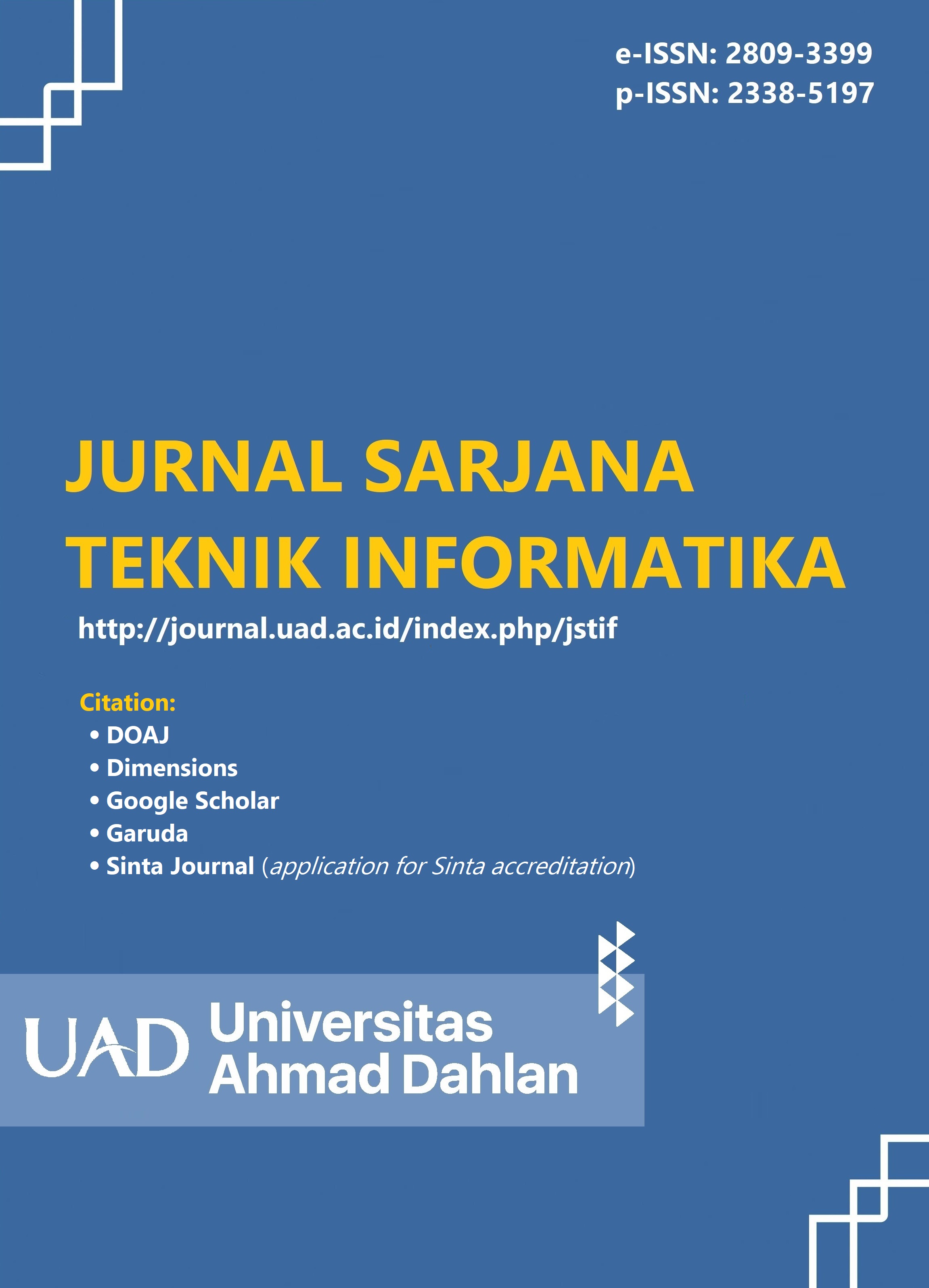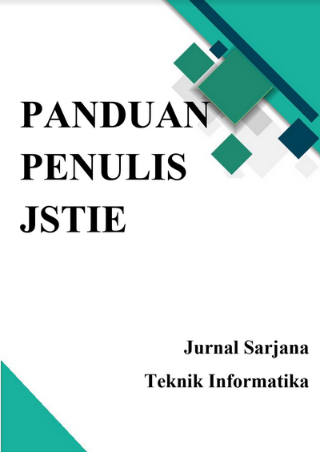Pemodelan Aset Game Spirit Call’s sebagai Media Pembelajaran Sejarah Budaya Indonesia dengan Game Development Life Cycle
DOI:
https://doi.org/10.12928/jstie.v13i1.28600Keywords:
Alpha Test, gldc, Game Edukasi, Model 3D, Aset 3DAbstract
Game edukasi spirit call’s ber-genre historical dan puzzle yang diadaptasi dari novel berjudul Maz Havelaar. Salah satu permasalahan dalam menyusun game edukasi adalah penyusunan aset yang berkualitas dan atraktif sehingga mempengaruhi daya tarik visual, meningkatkan pengalaman bermain, serta memicu reaksi emosional dari pemain. Penelitian ini bertujuan menyusun aset 3 dimensi (3D) game edukasi spirit call’s. Metode penelitian untuk menyusun aset game edukasi adalah Game Development Life Cycle (GDLC) yang terdiri dari initiation, pre-production, production, testing, dan release. Penelitian ini telah berhasil menyusun aset pada game edukasi spirit call’s yang memiliki kesesuaian dan kelayakan berdasarkan alpha test dan uji kualitas pemodelan. Hasil alpha test oleh 2 responden mengidentifikasi 95,38% menyampaikan sangat setuju dan setuju dengan luaran penelitian. Hasil pengujian lain terkait kualitas model oleh guru sejarah selaku pihak ahli mengidentifikasi 99% nilai sangat setuju dan setuju. Seluruh capaian penelitian ini berpotensi dilanjutkan dalam bentuk pengembangan suatu produk akhir berupa game edukasi spirit call’s.
References
[1] Abu Ahmadi and Widodo Supriyono, Psikologi Belajar, 3rd ed. Jakarta: PT. Rineka Cipta, 2013.
[2] D. Dwiyantoro, “Peran Taman Bacaan Masyarakat Mata Aksara dalam menumbuhkan minat baca pada masyarakat,” Jurnal Kajian Informasi & Perpustakaan, vol. 7, no. 1, Jun. 2019, doi: 10.24198/jkip.v7i1.14430.
[3] A. Sunanda et al., “Revitalisasi Perpustakaan untuk Meningkatkan Minat Baca dan Budaya Literasi Siswa MI Muhammadiyah Jambangan, Sragen,” Buletin KKN Pendidikan, vol. 2, no. 2, Sep. 2020, doi: 10.23917/bkkndik.v2i2.11842.
[4] T. Tafonao, “Peranan Media Pembelajaran Dalam Meningkatkan Minat Belajar Mahasiswa,” Jurnal Komunikasi Pendidikan, vol. 2, no. 2, p. 103, Aug. 2018, doi: 10.32585/jkp.v2i2.113.
[5] Charles James Tungka, “Nasionalisme yang Disajikan Multatuli dalam Karya Max Havelaar,” in Seminar Nasional Ilmu Terapan, Surabaya: Universitas Widya Kartika, Sep. 2019, pp. 1–6.
[6] Wandah Wibanto, Game Edukasi RPG (Role Playing Game), 1st ed., vol. 1. Semarang: LPPM Universitas Negeri Semarang, 2020.
[7] S. Sudaryanto and H. Hermanto, “The Use of Indonesian/Malay Orthography in Tempo Doeloe Advertisement and Its Implication for Indonesian Learning,” Transformatika: Jurnal Bahasa, Sastra, Dan Pengajarannya, vol. 2, no. 1, p. 58, Apr. 2018, doi: 10.31002/transformatika.v2i1.553.
[8] A. A. Herlijanto and T. A. Putra, “Perancangan Aset Visual 3D untuk Mobile Game Bertema Superhero,” Journal of Information System, Graphics, Hospitality and Technology, vol. 6, no. 1, pp. 8–16, Apr. 2024, doi: 10.37823/insight.v6i1.322.
[9] M. N. A. Ar Rohman, J. Samodra, and A. Sutrisno, “Desain Karakter 3D Game Anoman Obong untuk Remaja menggunakan Unity Render Toon Shading,” JoLLA: Journal of Language, Literature, and Arts, vol. 2, no. 2, pp. 151–167, Feb. 2022, doi: 10.17977/um064v2i22022p151-167.
[10] Ahmad Rizki Arianto, Kusnadi Kusnadi, and Suhadi Parman, “Pembuatan 3D Karakter Desain menggunakan Teknik LOD untuk Optimalisasi pada Game Mobile,” Jurnal Teknologi Informasi dan Komunikasi Sinar Nusantara, vol. 12, no. 2, pp. 1–10, 2022.
[11] Brillyan Jeniza Maulia and Hendro Aryanto, “Perancangan Desain Karakter Mobile Game ‘Pasaran Jawa’ untuk Edukasi Remaja,” Jurnal Desain Komunikasi Visual, vol. 4, no. 2, pp. 102–115, 2022.
[12] Wliana Wulandari and Hendro Aryanto, “Perancangan Desain Karakter Senjata Tradisional untuk Game Visual Novel berbasis PowerPoint,” Jurnal Desain Komunikasi Visual, vol. 2, no. 2, pp. 166–179, 2021.
[13] R. Ramadan and Y. Widyani, “Game development life cycle guidelines,” in 2013 International Conference on Advanced Computer Science and Information Systems (ICACSIS), IEEE, Sep. 2013, pp. 95–100. doi: 10.1109/ICACSIS.2013.6761558.
[14] M. Mustofa, J. L. Putra, and C. Kesuma, “Penerapan Game Development Life Cycle Untuk Video Game Dengan Model Role Playing Game,” Computer Science (CO-SCIENCE), vol. 1, no. 1, pp. 27–34, Jan. 2021, doi: 10.31294/coscience.v1i1.158.
[15] A. Z. Haqqi and B. Robiin, “Pemodelan 3D Senjata Tradisional Untuk GAMERPG Pengenalan Budaya Indonesia ‘SI BOLANG’ dengan Metode Blueprint dan Seamless Unwrapping Material,” JSTIE (Jurnal Sarjana Teknik Informatika) (E-Journal), vol. 9, no. 2, p. 66, Jun. 2021, doi: 10.12928/jstie.v9i2.20743.
[16] Mezano Muhammad, “Form and Gender Perception,” geometryarchitecture.
Downloads
Published
Issue
Section
License
Copyright (c) 2025 Muhammad Ikhsan Nur Falah, Bambang Robiin

This work is licensed under a Creative Commons Attribution-ShareAlike 4.0 International License.
License and Copyright Agreement
In submitting the manuscript to the journal, the authors certify that:
- They are authorized by their co-authors to enter into these arrangements.
- The work described has not been formally published before, except in the form of an abstract or as part of a published lecture, review, thesis, or overlay journal. Please also carefully read Journal Posting Your Article Policy.
- The work is not under consideration for publication elsewhere.
- The work has been approved by all the author(s) and by the responsible authorities – tacitly or explicitly – of the institutes where the work has been carried out.
- They secure the right to reproduce any material that has already been published or copyrighted elsewhere.
- They agree to the following license and copyright agreement.
Copyright
Authors who publish with Jurnal Sarjana Teknik Informatika agree to the following terms:
- Authors retain copyright and grant the journal right of first publication with the work simultaneously licensed under a Creative Commons Attribution License (CC BY-SA 4.0) that allows others to share the work with an acknowledgement of the work's authorship and initial publication in this journal.
- Authors are able to enter into separate, additional contractual arrangements for the non-exclusive distribution of the journal's published version of the work (e.g., post it to an institutional repository or publish it in a book), with an acknowledgement of its initial publication in this journal.
- Authors are permitted and encouraged to post their work online (e.g., in institutional repositories or on their website) prior to and during the submission process, as it can lead to productive exchanges, as well as earlier and greater citation of published work.








